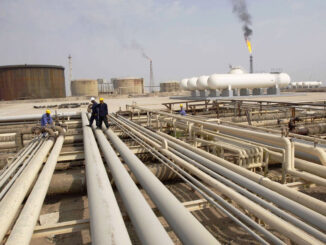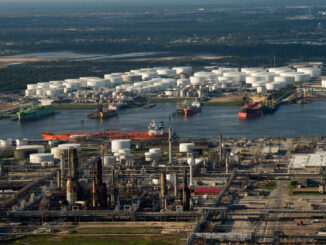
When Exxon Mobil Corp.’s newest addition to its southeast Texas refinery ramps up to full production in the next few weeks, it’ll be the first major expansion of US fuel-making capacity in at least a decade. And probably the last.
For Exxon, the timing has worked impeccably: It’s expanding supplies of diesel and a gasoline ingredient called vacuum gasoil, or VGO, just as customers are struggling to replace sanctioned Russian cargoes.In addition, the refinery expansion in the small industrial city of Beaumont, about a 90-minute drive from Houston, gives Exxon a guaranteed outlet for oil produced in the Permian Basin in West Texas and New Mexico. Using domestic crude nets Exxon more than $40 for every barrel of diesel produced, a historically eye-popping margin.
Exxon’s feat is unlikely to be replicated, given the industry-wide push to reduce carbon footprints and concurrent refinery construction across Africa, the Middle East and Asia that’ll swell global oil-processing capacity. In the US, gasoline consumption already has peaked, reducing any incentive for refiners to spend billions expanding output.
Even as US rivals like Marathon Petroleum Corp. and Valero Energy Corp. put the finishing touches on expansions at their own Texas refineries, they pale in comparison to Exxon’s mammoth 250,000-barrel increase in daily capacity that will make the Beaumont complex second in size to Saudi Aramco’s enormous plant in nearby Port Arthur.
“We’re pretty bullish on this project,” John Auers, managing director of RBN Energy’s Refined Fuels Analytics, said of Exxon’s expansion. “Theirs is likely the last major expansion in the US. They’re the last guys in.”
When Exxon launched the $2 billion Beaumont expansion project five years ago, the global refining industry was on the precipice of a dramatic slump that would see almost 4 million barrels of daily fuel-making capacity mothballed as the pandemic gutted energy demand and tougher environmental rules made the oldest, dirtiest plants unprofitable to operate.
But for Exxon, the mathematics of what a bigger Beaumont would mean for its bottom line were compelling. Despite what was transpiring in the wider world of refining, Exxon’s Permian crude was so cheap to produce and inexpensive to haul to the plant that the investment was justified, said Chief Executive Officer Darren Woods.
Exxon “justified that project purely on logistics optimizations and lower-cost transportation to feed that refinery” Woods told analysts during a Jan. 31 conference call. “We leaned in when others leaned out, bucking conventional wisdom.”
The refinery’s daily capacity will increase almost 70% to about 619,000 barrels, becoming almost as large as the Saudis’ 626,000-barrel complex in neighboring Port Arthur.
In contrast, Exxon’s smaller rivals are engaged in less ambitious projects. Marathon Petroleum is close to completing an expansion of its Galveston Bay refinery that will add 40,000 barrels of daily crude capacity. Meanwhile, Valero is scheduled to add 100,000 barrels of daily capacity to its Port Arthur complex.
Exxon’s advantage over both of those peers is that it has its own source of crude. Because they don’t possess wells, pure-play refiners such as Marathon Petroleum and Valero are more exposed to oil-market gyrations.
What Exxon’s new Crude C Unit means for the Beaumont refinery:
Every 24 hours:
100,000 barrels of distillate fuels
includes diesel, jet fuel and heating oil
20,000 barrels of gasoline
100,000 barrels of VGO and other feedstocks
Several new hydrotreating apparatuses to support the crude unit
Exxon’s expansion also creates a new source of vacuum gasoil, or VGO, which is in high demand among US refiners cut off from Russian production that was their single largest foreign source of the component prior to the war in Ukraine.“When Exxon conceived the expansion, I’m sure it was about feedstock,” said Amrita Sen, co-founder and director of research at London consultancy Energy Aspects. “Now it’s more about refinery shortages.”
To be sure, there are major refinery expansions underway outside the US. A slate of new Middle East projects are in various stages of coming online, according to Sen.
So-called refinery runs are seen rising by 1.7 million barrels this year compared with 2022, according to Energy Aspects, with most of it concentrated in the second half and dedicated to a class of fuels called middle distillates that includes diesel. In the US, the expansion trend may be offset somewhat by LyondellBasell Industries NV’s planned closure of a Houston complex as well as the conversion of two California refineries to renewable-diesel production.
Exxon’s new firepower comes as domestic stockpiles of diesel and similar fuels are 10% below the 10-year average for this time of year. The shortfall is even more acute along the East Coast, where the deficit is 16%.
Unpredictable Markets
The Beaumont plant in the state’s far southeast tip close to the Louisiana border sits at the nexus of fuel production and demand: The Colonial Pipeline can haul the region’s fuel to East Coast markets while nearby Gulf Coast ports can load it onto tankers bound for international destinations.
For his part, CEO Woods doesn’t pretend the expansion was undertaken with an eye to capturing profits from an upward cycle no one else saw coming.
“We can’t call the cycles,” Woods said during the late-January conference call. “We can’t predict where the markets will go and over what time frame, but we can control the cost of the barrels that we’re bringing on.”
Share This:



